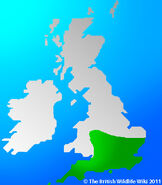
Stag Beetle, female - D Shenton
The Stag Beetle (Lucanus cervus) lives in holes in old trees and dead trunks, in the forest as well as in groves. Forest management, in eliminating old trees and deadwood, eliminates at the same time the habitat and food of this species. Once quite common, the population of the Lucanus cervus, along with that of other species of beetles which feed on wood, is in steep decline, and is now listed as a globally threatened/declining species.
Description[]
Adults appear during late May to the beginning of August being most active in the evenings. Females lay their eggs in a piece of decaying wood. Stag beetle larvae, which are blind and shaped like a letter "C", feed on rotting wood in a variety of places, tree stumps, old trees and shrubs, rotting fence posts, compost heaps and leaf mould. The larvae have a cream-coloured soft transparent body with six orange legs, and an orange head which is very distinct from the very sharp brown pincers. They have combs in their legs which they use for communication (stridulation) with other larvae. The larvae go through several developmental stages (instars), taking 4 to 6 years to become pupae. Adults only live for a few months feeding on nectar and tree sap. Their slow, lumbering flight, usually at dusk, makes a distinctive low-pitched buzzing sound. The males fly more readily than the females.

When the Stag Beetle is active
The natural reaction of the beetle to an approaching large object is to remain motionless making them a good photographic subject. Sexually dimorphic, the males have enlarged mandibles and are larger than the females. Although the male's mandibles seem threatening, they are too weak to be harmful. Nevertheless, females can inflict a painful bite. It is the resemblance of the male's mandibles to the horns of a stag, and their use in combat between males, much like with deer, that gives the species its scientific and common names.
Protection[]
Lucanus cervus is registered in the second appendix of the Habitats Directive of the European Union from 1992, which requires that member states set aside Special Areas of Conservation. The species is also registered in the third appendix of the Convention on the Conservation of European Wildlife and Natural Habitats (Berne convention) of 1982 and Schedule 5 of the UK's Wildlife and Countryside Act 1981.
Gallery[]
[[Category:]]

